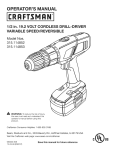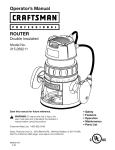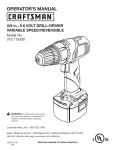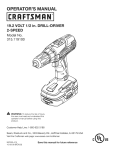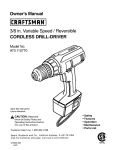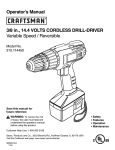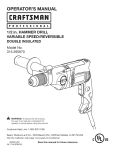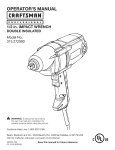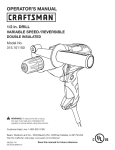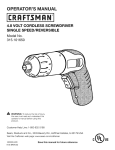Download Craftsman 315.115510 Operator`s manual
Transcript
PERATOR'S MAN AL ® 3/8 in., 19.2 VOLT CORDLESS DRILL VARIABLE SPEED/REVERSIBLE Model No. 315.115510 A WARNING: To reduce the risk of injury, the user must read and understand the operator's manual before using this product. Customer Help Line: 1-800-932-3188 Sears, Roebuck and Co., 3333 Beverly Rd., Hoffman Estates, IL 60179 USA Visit the Craftsman web page: www.sears.com/craftsman 987000-008 06-13-08 (REV:02) Save this manual for future reference [] Warranty .......................................................................................................................................................................... 2 [] Introduction ..................................................................................................................................................................... 2 [] General Safety Rules .................................................................................................................................................... 3-4 [] Specific Safety Rules ....................................................................................................................................................... 4 [] Safety Rules for Charger ................................................................................................................................................. 5 [] Symbols ........................................................................................................................................................................ 6-7 [] Features ........................................................................................................................................................................ 8-9 [] Assembly ......................................................................................................................................................................... 9 [] Operation .................................................................................................................................................................. 10-15 [] Maintenance ............................................................................................................................................................. 16-17 [] Exploded View and Parts List ........................................................................................................................................ [] Parts Ordering/Service ..................................................................................................................................... ONE-YEAR FULL WARRANTY ON CRAFTSMAN 18 Back Page TOOL If this Craftsman tool fails to give complete satisfaction within one year from date of purchase, RETURN iT TO ANY SEARS STORE OR PARTS AND REPAIR CENTER OR OTHER CRAFTSMAN OUTLET iN THE UNITED STATES FOR FREE REPAIR. If this Craftsman tool is used for commercial purchase. or rental purposes, this warranty applies for only 90 days from the date of This warranty gives you specific legal rights, and you may also have other rights which vary from state to state. Sears, Roebuck and Co., Dept. 817WA, Hoffrnan Estates, IL 60179 This tool has many features for making its use more pleasant and enjoyable. Safety, performance, have been given top priority in the design of this product making it easy to maintain and operate. A and dependability WARNING: Some dust created by power sanding, sawing, grinding, drilling, and other construction activities contains chemicals known to cause cancer, birth defects or other reproductive harm. Some examples of these chemicals are: • lead from lead-based paints, • crystalline silica from bricks and cement and other masonry products, and • arsenic and chromium from chemically-treated lumber. Your risk from these exposures varies, depending on how often you do this type of work. To reduce your exposure to these chemicals: work in a well ventilated area, and work with approved safety equipment, such as those dust masks that are specially designed to filter out microscopic particles. A WARNING! Read and understand aii instructions. Failure to follow all instructions listed below, may result in electric shock, fire and/or serious personal injury. SAVE THESE WORK AREA INSTRUCTIONS [] Keep your work area clean and well lit. Cluttered benches and dark areas invite accidents. [] Do not operate power tools in explosive atmospheres, such as in the presence of flammable liquids, gases, or dust. Power tools create sparks which may ignite the dust or fumes. [] Keep bystanders, children, and visitors away while operating a power tool. Distractions can cause you to lose control. ELECTRICAL SAFETY [] A battery operated tool with integral batteries or a separate battery pack must be recharged only with the specified charger for the battery. A charger that may be suitable for one type of battery may create a risk of fire when used with another battery. [] Use battery operated tool only with specifically designated battery pack. Use of any other batteries may create a risk of fire. [] Use battery MODEL 315.115510 only with charger BATTERY PACK listed. CHARGER Model No. 1425301 (Item No. 911041) Model No. 315.115730 (Item No. 140301003) [] Do not abuse the cord. Never use the cord to carry the tool. Keep cord away from heat, oil, sharp edges, or moving parts. Replace damaged cords immediately. Damaged cords may create a fire. PERSONAL 130279003 130279005 (Item No. 911375) SAFETY [] Stay alert, watch what you are doing and use common sense when operating a power tool. Do not use tool while tired or under the influence of drugs, alcohol, or medication. A moment of inattention while operating power tools may result in serious personal injury. [] Dress properly. Do not wear loose clothing or jewelry. Contain long hair. Keep your hair, clothing, and gloves away from moving parts. Loose clothes, jewelry, or long hair can be caught in moving parts. [] Avoid accidental starting. Be sure switch is in the locked or off position before inserting battery pack. Carrying tools with your finger on the switch or inserting the battery pack into a tool with the switch on invites accidents. [] Remove adjusting keys or wrenches before turning the tool on. A wrench or a key that is left attached to a rotating part of the tool may result in personal injury. [] Do not overreach. Keep proper footing and balance at all times. Proper footing and balance enable better control of the tool in unexpected situations. [] Use safety equipment. Always wear eye protection. Dust mask, non-skid safety shoes, hard hat, or hearing protection must be used for appropriate conditions. [] Do not wear loose clothing or jewelry. Contain long hair. Loose clothes, jewelry, or long hair can be drawn into air vents. [] Do not use on a ladder or unstable support. Stable footing on a solid surface enables better control of the tool in unexpected situations. TOOL USE AND CARE [] Use clamps or other practical way to secure and support the workpiece to a stable platform. Holding the work by hand or against your body is unstable and may lead to loss of control. [] Do not force tool. Use the correct tool for your application. The correct tool will do the job better and safer at the rate for which it is designed. [] Do not use tool if switch does not turn it on or off. A tool that cannot be controlled with the switch is dangerous and must be repaired. [] Disconnect battery pack from tool or place the switch in the locked or off position before making any adjustments, changing accessories, or storing the tool. Such preventive safety measures reduce the risk of starting the tool accidentally. [] Store idle tools out of reach of children and other untrained persons. Tools are dangerous in the hands of untrained users. [] When battery pack is not in use, keep it away from other metal objects like: paper clips, coins, keys, nails, screws, or other small metal objects that can make a connection from one terminal to another. Shorting the battery terminals together may cause sparks, burns, or a fire. [] Maintain tools with care. Keep cutting tools sharp and clean. Properly maintained tools with sharp cutting edges are less likely to bind and are easier to control. [] Check for misalignment or binding of moving parts, breakage of parts, and any other condition that may affect the tool's operation, if damaged, have the tool serviced before using. Many accidents are caused by poorly maintained tools. [] Use only accessories that are recommended by the manufacturer for your model. Accessories that may be suitable for one tool may create a risk of injury when used on another tool. [] Keep the tool and its handle dry, clean and free from oil and grease. Always use a clean cloth when cleaning. Never use brake fluids, gasoline, petroleumbased products, or any strong solvents to clean your tool. Following this rule will reduce the risk of loss of control and deterioration of the enclosure plastic. SERVICE [] Tool service must be performed only by qualified repair personnel. Service or maintenance performed by unqualified personnel may result in a risk of injury. [] When servicing a tool, use only identical replacement parts. Follow instructions in the Maintenance section of this manual. Use of unauthorized parts or failure to follow Maintenance Instructions may create a risk of shock or injury. [] Hold tool by insulated gripping surfaces when performing an operation where the cutting tool may contact hidden wiring. Contact with a "live" wire will also make exposed metal parts of the tool "live" and shock the operator. [] Do not crush, drop or damage battery pack. Do not use a battery pack or charger that has been dropped or received a sharp blow. A damaged battery is subject to explosion. Properly dispose of a dropped or damaged battery immediately. [] Know your power tool. Read operator's manual carefully. Learn its applications and limitations, as well as the specific potential hazards related to this tool. Following this rule will reduce the risk of electric shock, fire, or serious injury. [] Batteries vent hydrogen gas and can explode in the presence of a source of ignition, such as a pilot light. To reduce the risk of serious personal injury, never use any cordless product in the presence of open flame. An exploded battery can propel debris and chemicals. If exposed, flush with water immediately. [] Always wear safety glasses with side shields. Everyday glasses have only impact resistant lenses. They are NOT safety glasses. Following this rule will reduce the risk of eye injury. [] Protect your lungs. Wear a face or dust mask if the operation is dusty. Following this rule will reduce the risk of serious personal injury. [] Protect your hearing. Wear hearing protection during extended periods of operation. Following this rule will reduce the risk of serious personal injury. [] Do not charge battery tool in a damp or wet location. Following this rule will reduce the risk of electric shock. [] For best results, your battery tool should be charged in a location where the temperature is more than 50°F but less than 100°F. Do not store outside or in vehicles. [] Battery tools do not have to be plugged into an electrical outlet; therefore, they are always in operating condition. Be aware of possible hazards when not using your battery tool or when changing accessories. Following this rule will reduce the risk of electric shock, fire, or serious personal injury. [] Under extreme usage or temperature conditions, battery leakage may occur. If liquid comes in contact with your skin, wash immediately with soap and water, then neutralize with lemon juice or vinegar. If liquid gets into your eyes, flush them with clean water for at least 10 minutes, then seek immediate medical attention. Following this rule will reduce the risk of serious personal injury. [] Do not place battery tools or their batteries near fire or heat. This will reduce the risk of explosion and possibly injury. [] If the power supply cord is damaged, it must be replaced only by the manufacturer or by an authorized service center to avoid risk. _1_ WARNING!READANDUNDERSTAND ALL INSTRUCTIONS. Failure to follow aii instructions listed below, may result in electric shock, fire and/or serious personal injury. [] Before using battery charger, read all instructions and cautionary markings in this manual, on battery charger, battery, and product using battery to prevent misuse of the products and possible injury or damage. CAUTION: To reduce the risk of electric shock or damage to the charger and battery, charge only nickel-cadmium rechargeable batteries as specifically designated on your charger. Other types of batteries may burst, causing personal injury or damage. [] An extension cord should not be used unless absolutely necessary. Use of improper extension cord could result in a risk of fire and electric shock. If extension cord must be used, make sure: a. That pins on plug of extension cord are the same number, size and shape as those of plug on charger. b. That extension cord is properly wired and in good electrical condition; and c. That wire size is large enough for AC ampere rating of charger as specified below: Cord Length (Feet) 25' 50' 100' Cord Size (AWG) 16 16 16 NOTE: AWG = American Wire Gauge [] Do not use charger outdoors or expose to wet or damp conditions. Water entering charger will increase the risk of electric shock. [] Do not operate charger with a damaged cord or plug, which could cause shorting and electric shock. If damaged, have the charger replaced by an authorized serviceman. [] Use of an attachment not recommended or sold by the battery charger manufacturer may result in a risk of fire, electric shock, or injury to persons. Following this rule will reduce the risk of electric shock, fire, or serious personal injury. [] Do not operate charger if it has received a sharp blow, been dropped, or otherwise damaged in any way. Take it to an authorized serviceman for electrical check to determine if the charger is in good working order. [] Do not abuse cord or charger. Never use the cord to carry the charger. Do not pull the charger cord rather than the plug when disconnecting from receptacle. Damage to the cord or charger could occur and create an electric shock hazard. Replace damaged cords immediately. [] Make sure cord is located so that it will not be stepped on, tripped over, come in contact with sharp edges or moving parts or otherwise subjected to damage or stress. This will reduce the risk of accidental falls, which could cause injury, and damage to the cord, which could result in electric shock. [] Keep cord and charger from heat to prevent damage to housing or internal parts. [] Do not let gasoline, oils, petroleum-based products, etc. come in contact with plastic parts. They contain chemicals that can damage, weaken, or destroy plastic. [] [] Do not disassemble charger. Take it to an authorized serviceman when service or repair is required. Incorrect reassembly may result in a risk of electric shock or fire. [] Unplug charger from outlet before attempting any maintenance or cleaning to reduce the risk of electric shock. [] Disconnect charger from the power supply when not in use. This will reduce the risk of electric shock or damage to the charger if metal items should fall into the opening. It also will help prevent damage to the charger during a power surge. [] Risk of electric shock. Do not touch uninsulated portion of output connector or uninsulated battery terminal. [] Save these instructions. Refer to them frequently and use them to instruct others who may use this tool. If you loan someone this tool, loan them these instructions also to prevent misuse of the product and possible injury. I PORTANT SAFETY iNSTRUCTiON SAVE TH I ST UCT This manual contains important safety and operating instructions for battery charger 1425301 (item No. 911 041) and 315.115730 (Item No. 140301003). [] 3. Before using battery charger, read all instructions and cautionary markings on battery charger, battery, and product using battery. CAUTION: To reduce the risk of injury, charge only nickel-cadmium rechargeable batteries. Other types of batteries may burst, causing personal injury or damage. 5 Someofthefollowingsymbolsmaybeusedonthistool.Pleasestudythemandlearntheirmeaning• Properinterpretationofthesesymbolswillallowyouto operatethetoolbetterandsafer• SYMBOL NAME DESIGNATION/EXPLANATION V Volts Voltage A Amperes Current Hz Hertz Frequency (cycles per second) W Watt Power Minutes Time Alternating Current Type of current Direct Current Type or a characteristic of current n o No Load Speed Rotational speed, at no load [] Class II Tool Double-insulated •../min Per Minute Revolutions, strokes, surface speed, orbits etc., per minute @ Wet Conditions Alert Do not expose to rain or use in damp locations• Read The Operator's Manual To reduce the risk of injury, user must read and understand operator's manual before using this product• Eye Protection Always wear safety goggles or safety glasses with side shields and, as necessary, a full face shield when operating this product• Safety Alert Precautions that involve your safety• No Hands Symbol Failure to keep your hands away from the blade will result in serious personal injury• No Hands Symbol Failure to keep your hands away from the blade will result in serious personal injury• No Hands Symbol Failure to keep your hands away from the blade will result in serious personal injury• No Hands Symbol Failure to keep your hands away from the blade will result in serious personal injury• Hot Surface To reduce the risk of injury or damage, avoid contact with any hot surface• min O @ @ @ ® construction Thefollowingsignalwordsandmeanings areintendedto explainthelevelsofriskassociated withthisproduct. SYMBOL SIGNAL MEANING DANGER: Indicates an imminently hazardous situation, which, if not avoided, will result in death or serious injury. WARNING: Indicates a potentially hazardous situation, which, if not avoided, could result in death or serious injury. CAUTION: Indicates a potentially hazardous result in minor or moderate injury.situation, which, if not avoided, may CAUTION: (Without Safety Alert Symbol) Indicates a situation that may result in property damage. = A SERVICE Servicing requires extreme care and knowledge and should be performed only by a qualified service technician. For service we suggest you return the product to your nearest SEARS OR OTHER QUALIFIED SERVICE CENTER for repair. When servicing, use only identical replacement parts. ,_ WARNING: To avoid serious personal injury, do not attempt to use this product until you read thoroughly and understand completely the operator's manual. If you do not understand the warnings and instructions in the operator's manual, do not use this product. Call Sears customer service for assistance. WARNING: The operation of any power tool can result in foreign objects being thrown into your eyes, which can result in severe eye damage. Before beginning power tool operation, always wear safety goggles or safety glasses with side shields and, when needed, a full face shield. We recommend Wide Vision Safety Mask for use over eyeglasses or standard safety glasses with side shields. Always use eye protection which is marked to comply with ANSI Z87.1. SAVE THESE INSTRUCTIONS PRODUCT SPECiFiCATiONS Chuck .......................................................... 3/8 in. Keyless Motor ............................................................... 19.2 Volt DC Clutch ................................................................ 24 Position Torque ................................................................... 410 in.lb. Switch .............................. VSR (Variable Speed Reversible) Charger Input .................................... Gear Train .............................................................. Charge Rate ............................................................. No Load Speed ....................... 0-400/0-1,400 2 Speed 120 V, 60 Hz, AC only 1 hour r/rain. (RPM) LEVEL TWO-SPEED GEARTRAIN (HI&O) ADJUSTMENT TORQUERiNG X LEVEL KEYLESS CHUCK REARViEW SWITCH TRIGGER DIRECTIONOF ROTATIONSELECTOR (FORWARD/REVERSE/ CENTERLOCK) SCREWDRIVER BITS BATTERYPACK SHOWNIN CHARGER BiT STORAGE BATTERY PACK CHARGER 4-1/2 in. Fig. 1 KNOW YOUR DRILL See Figure 1. The safe use of this product requires an understanding of the information on the product and in this operator's manual as well as a knowledge of the project you are attempting. Before use of this product, familiarize yourself with all operating features and safety rules. BIT STORAGE Bits provided with the drill can be placed in the storage area, located on the base of the drill CHARGER KEYLESS The keyless chuck allows you to hand-tighten the drill bit in the chuck jaws. DIRECTION OF ROTATION SELECTOR (FORWARD/REVERSE/CENTER LOCK) Your drill has a direction of rotation (forward/reverse/ center lock) selector located above the switch trigger for changing the direction of bit rotation. Setting the switch trigger in the OFF (center lock) position helps reduce the possibility of accidental starting when not in use. UNPACKING This product has been shipped completely assembled. Levels are located on the top and end of the motor housing to help keep the drill bit level during use. TORQUE ADJUSTMENT VARIABLE Battery Pack Charger Double-ended Bit (2) Operator's Manual SPEED The variable speed switch trigger delivers higher speed with increased trigger pressure and lower speed with decreased trigger pressure. _, A [] If any parts are damaged or missing, please call 1-800-932-3188 for assistance. 3/8 in. Drill GEAR TRAIN The two-speed gear train is designed for drilling or driving at LO (1) or HI (2) speeds. A slide switch is located on top of your drill for selecting either LO (1) or Hi (2} speed. [] Do not discard the packing material until you have carefully inspected and satisfactorily operated the tool. LIST RING Your drill has a 24-position clutch. The torque adjustment ring can be turned to select the right amount of torque for your application. [] Carefully remove the tool and any accessories from the box. Make sure that all items listed in the packing list are included. [] Inspect the tool carefully to make sure no breakage or damage occurred during shipping. or release LEVELS TWO SPEED The charger has a key-hole hanging feature for convenient, space-saving storage. Screws should be installed so that the center distance is 4-1/2 in. PACKING CHUCK A WARNING: If any parts are damaged or missing do not operate this tool until the parts are replaced. Failure to do so could result in possible serious personal injury. WARNING: Do not attempt to modify this tool or create accessories not recommended for use with this tool. Any such alteration or modification is misuse and could result in a hazardous condition leading to possible serious personal injury. WARNING: To prevent accidental starting that could cause serious personal injury, always remove the battery pack from the tool when assembling parts. A A A CHARGING WARNING: Do not allow familiarity with tools to make you careless. Remember that a careless fraction of a second is sufficient to inflict serious injury. [] Charge the battery pack only with the charger provided. [] Make sure the power supply is normal household voltage, 120 volts, 60 Hz, AC only. [] Connect the charger to the power supply. [] Place the battery pack in the charger aligning raised rib on the battery pack with the groove in the charger. See Figure 2. [] Press down on the battery pack to be sure contacts on the battery pack engage properly with contacts in the charger. APPLICATIONS You may use this tool for the purposes listed below: [] Normally the red LED on charger will come on. This indicates the charger is in fast charging mode. [] Drilling in wood [] Drilling in ceramics, plastics, fiberglass, and laminates [] Red LED should remain on for approximately 1 hour then the green LED will come on. Green LED on indicates battery pack is fully charged and charger is in maintenance charge mode. [] Drilling in metals [] Mixing paint CAUTION: If at any point during the charging process none of the LEDs are lit, remove the battery pack from the charger to avoid damaging the product. DO NOT insert another battery. Return the charger and battery to your nearest Sears or other qualified service center for service or replacement. NOTE: The green LED will remain on until the battery pack is removed from the charger or charger is disconnected from the power supply. [] If both yellow and green LEDs come on, this indicates a deeply discharged or defective battery pack. Allow the battery pack to remain in the charger for 15 to 30 minutes. When the battery pack reaches normal voltage range, the red LED should come on. If the red LED does not come on after 30 minutes, this may indicate a defective battery pack and should be replaced. OF CHARGER BE ON TO INDICATE STATUS AND BATTERY PACK: OF [] Red LED on = Fast charging mode. [] After normal usage, a minimum of 1 hour of charging time is required to fully recharge battery pack. [] Green LED on = Fully charged and in maintenance charge mode. [] The battery pack will become slightly warm to the touch while charging. This is normal and does not indicate a problem. [] Green LED on = When battery pack is inserted into charger, indicates hot battery pack or that battery pack is out of normal temperature range. [] Do not place the charger and battery pack in an area of extreme heat or cold. They will work best at normal room temperature. [] Yellow and Green LEDs on = Deeply discharged or defective battery pack. [] No LED on = Defective charger or battery pack. CHARGING THE BATTERY PACK NOTE: If the charger does not charge the battery pack under normal circumstances, return both the battery pack and charger to your nearest Sears or other qualified service center for electrical check. WARNING: Do not use any attachments or accessories not recommended by the manufacturer of this tool. The use of attachments or accessories not recommended can result in serious personal injury. LED WILL CHARGER BATTERY If battery pack is below normal temperature range, the green LED on charger will come on. Allow battery pack to reach normal temperature, then the red LED will come on. WARNING: Always wear safety goggles or safety glasses with side shields when operating tools. Failure to do so could result in objects being thrown into your eyes, resulting in possible serious injury. LED FUNCTIONS A COOL NOTE: The charger and battery pack should be placed in a location where the temperature is more than 50°F but less than 100°F. PACK The battery pack for this tool has been shipped in a low charge condition to prevent possible problems. Therefore, you should charge it until the green LED on the front of the charger comes on. [] When batteries become fully charged, unplug the charger from power supply and remove the battery pack. NOTE: Batteries will not reach full charge the first time they are charged. Allow several cycles (operation followed by recharging) for them to become fully charged. 10 CHARGING A HOT BATTERY PACK TO iNSTALL BATTERY PACK See Figure 3. When using the tool continuously, the batteries in the battery pack will become hot. You should let a hot battery pack cool down for approximately 30 minutes before attempting to recharge. When the battery pack becomes discharged and is hot, this will cause the green LED to come on instead of the red LED. After 30 minutes, reinsert the battery pack in the charger. If the green LED continues to remain on, return battery pack to your nearest Sears or other qualified service center for checking or replacing. [] Lock switch trigger on the drill by placing the direction of rotation selector in center position. [] Place battery pack in the drill. Align raised rib on battery pack with groove inside drill. CAUTION: When placing battery pack in the drill, be sure raised rib on battery pack aligns with groove inside drill and latches snap into place properly. Improper assembly of battery pack can cause damage to internal components. NOTE: This situation only occurs when continuous use of the tool causes the batteries to become hot. It does not occur under normal circumstances. Refer to CHARGING A COOL BATTERY PACK for normal recharging of batteries. If the charger does not charge your battery pack under normal circumstances, return both the battery pack and charger to your nearest Sears or other qualified service center for electrical check. [] Make sure the latches on each side of your battery pack snap in place and battery pack is secured in drill before beginning operation. TO REMOVE BATTERY PACK See Figure 3. [] Lock switch trigger on the drill by placing the direction of rotation selector in center position. BATTERYPACK SHOWNIN CHARGER [] Locate latches on side of battery pack and depress to release battery pack from the drill. [] Remove battery pack from the drill. CHARGER RED LED GREENLED BATTERY PACK YELLOW LED LATCHES Fig. 2 DEPRESSLATCHESTO RELEASEBATTERYPACK 11 Fig. 3 A To stop the drill, release the switch trigger and allow the chuck to come to a complete stop. NOTE: The drill will not run unless the direction of rotation WARNING: Battery tools are always in operating condition. Therefore, switch should always be locked when not in use or carrying at your side. selector is pushed fully to the left or right. DIRECTIONOF ROTATIONSELECTOR (FORWARD/REVERSE/CENTER LOCK) Avoid running the drill at low speeds for extended periods of time. Running at low speeds under constant usage may cause the drill to become overheated. If this occurs, cool the drill by running it without a load and at full speed. REVERSE KEYLESS CHUCK See Figure 5. The drill has a keyless chuck to tighten or release drill bits in the chuck jaws. Grasp and hold the collar of the chuck with one hand. Rotate the chuck body with your other hand. The arrows on the chuck indicate which direction to rotate the chuck body in order to LOCK (tighten) or UNLOCK (release) the drill bit. A VARIABLESPEED SWITCHTRIGGER SWITCH Fig. 4 TRIGGER See Figure 4. To turn the drill ON, depress the switch trigger. To turn it OFF, release the switch trigger. VARIABLE WARNING: Do not hold the chuck body with one hand and use the power of the drill to tighten the chuck jaws on the drill bit. The chuck body could slip in your hand, or your hand could slip and come in contact with the rotating drill bit. This could cause an accident resulting in serious personal injury. KEYLESS CHUCK UNLOCK CHUCK SPEED The variable speed switch trigger delivers higher speed with increased trigger pressure and lower speed with decreased trigger pressure. NOTE: You might hear a whistling or ringing noise from the switch during use. Do not be concerned; this is a normal part of the switch function. DIRECTION OF ROTATION SELECTOR (FORWARD/REVERSE/CENTER LOCK} See Figure 4. The direction of bit rotation is reversible and is controlled by a selector located above the switch trigger. With the drill held in normal operating position, the direction of rotation selector should be positioned to the left of the switch trigger for drilling. The drilling direction is reversed when the selector is to the right of the switch trigger. Fig. 5 Setting the switch trigger in the OFF (center lock) position helps reduce the possibility of accidental starting when not in use. CAUTION: To prevent gear damage, always allow the chuck to come to a complete stop before changing the direction of rotation. 12 TWO=SPEED GEAR TRAIN TO DECREASE TORQUE See Figure 6. ADJUSTING RiNG The drill has a two-speed gear train designed for drilling or driving at LO (1) or HI (2) speeds. A slide switch is located on top of the drill to select either LO (1) or HI (2) speed. When using drill in the LO (1) speed range, speed will decrease and unit will have more power and torque. When using drill in the Hi (2) speed range, speed will increase and unit will have less power and torque. Use LO (1) speed for high power and torque applications and Hi (2) speed for fast drilling or driving applications. TWO SPEED GEARTRAIN(HI-LO) LD SPEED TO INCREASE TORQUE Fig. 7 SPEED BIT STORAGE See Figure 8. When not in use, bits provided with the drill can be placed in the storage area located on the base of the drill. SCREWDRIVER BIT Fig. 6 ADJUSTABLE TORQUE CLUTCH This product is equipped with an adjustable torque clutch for driving different types of screws into different materials. The proper setting depends on the type of material and the size of screw you are using. ADJUSTING TORQUE BiTSTORAGEAREA See Figure 7. [] There are twenty-four torque indicator settings located on the front of the drill. Fig. 8 [] Rotate the adjusting ring to the desired setting. • 1-4 For driving small screws 5-8 For driving screws into soft material 9-12 For driving screws into soft and hard materials ® 13-16 For driving screws into hard wood ® 17 -23 For driving large screws ® For heavy drilling 13 INSTALLINGBITS See Figures 9 - 10. [] Lock the switch trigger by placing the direction of rotation selector in the center position. [] Open or close the chuck opening is slightly larger use. Also, raise the front bit from falling out of the jaws to a point where the than the bit size you intend to of the drill slightly to keep the chuck jaws. [] Insert the drill bit. _ WARNING: Make sure to insert the drill bit straight into the chuck jaws. Do not insert the drill bit into the chuck jaws at an angle then tighten, as shown in figure 10. This could cause the drill bit to be thrown from the drill, resulting in possible serious personal injury or damage to the chuck. Fig. 10 DRILLING See Figures 11 - 12. [] Tighten the chuck jaws on the drill bit. NOTE: Rotate the chuck body in the direction of the arrow marked LOCK to tighten the chuck jaws. Do not use a wrench to tighten or loosen the chuck jaws. KEYLESS CHUCK DRILLBIT UNLOCK (RELEASE) Levels are located on the top and end of the motor housing to help keep the drill bit level during use. [] Check the direction of rotation selector for the correct setting (forward or reverse). [] Secure the material to be drilled in a vise or with CHUCK COLLAR clamps to keep it from turning as the drill bit rotates. [] Hold the drill firmly and place the bit at the point to be drilled. [] Depress the switch trigger to start the drill. [] Move the drill bit into the workpiece, applying only enough pressure to keep the bit cutting. Do not force the drill or apply side pressure to elongate a hole. Let the tool do the work. _ CHUCK JAWS LOCK (TIGHTEN) REMOVING Be prepared for binding at bit breakthrough. When these situations occur, drill has a tendency to grab and kick opposite to the direction of rotation and could cause loss of control when breaking through material. If not prepared, this loss of control can result in possible serious injury. CHUCK BODY BIGHT WARNING: [] When drilling hard, smooth surfaces, use a center punch to mark the desired hole location. This will prevent the drill bit from slipping off-center as the hole is started. Fig. 9 BITS See Figure 9. [] When drilling metals, use a light oil on the drill bit to keep it from overheating. The oil will prolong the life of the bit and increase the drilling action. [] Lock the switch trigger by placing the direction of rotation selector in the center position. [] Open the chuck jaws. [] If the bit jams in the workpiece or if the drill stalls, stop the tool immediately. Remove the bit from the workpiece and determine the reason for jamming. NOTE: Rotate the chuck body in the direction of the arrow marked UNLOCK to loosen the chuck jaws. Do not use a wrench to tighten or loosen the chuck jaws. [] Remove the drill bit. NOTE: This drill has an electric brake. When the switch trigger is released, the chuck stops turning. When the brake is functioning properly, sparks will be visible through the vent slots on the housing. This is normal and is the action of the brake. 14 WOOD DRILLING For maximum performance, wood drilling. use high speed steel bits for [] Select normal drilling mode. [] Begin drilling at a very low speed to prevent the bit from slipping off the starting point. Increase the speed as the drill bit bites into the material. LEVEL__ [] When drilling through holes, place a block of wood behind the workpiece to prevent ragged or splintered edges on the back side of the hole. METAL DR(LLiNG For maximum performance, metal or steel drilling. use high speed steel bits for [] Select normal drilling mode. [] Begin drilling at a very low speed to prevent the bit from slipping off the starting point. [] Maintain a speed and pressure which allows cutting without overheating the bit. Applying too much pressure will: Fig. 11 • Overheat the drill; Wear the bearings; LEVEL Bend or burn bits; and Produce off-center or irregular-shaped holes. [] When drilling large holes in metal, start with a small bit, then finish with a larger bit. Also, lubricate the bit with oil to improve drilling action and increase bit life. Fig. 12 15 A A A GENERAL WARNING: When servicing, use only identical Craftsman replacement parts. Use of any other part may create a hazard or cause product damage. MAINTENANCE Avoid using solvents when cleaning plastic parts. Most plastics are susceptible to damage from various types of commercial solvents and may be damaged by their use. Use clean cloths to remove dirt, dust, oil, grease, etc. WARNING: Always wear safety goggles or safety glasses with side shields when using compressed air to clean products. If the operation is dusty, also wear a dust mask. ,_', WARNING: Do not at any time let brake fluids, gasoline, petroleum-based products, penetrating oils, etc. come in contact with plastic parts. Chemicals can damage, weaken or destroy plastic which may result in serious personal injury. WARNING: To avoid serious personal injury, always remove the battery pack from the product when cleaning or performing any maintenance. Only the parts shown on the parts list are intended to be repaired or replaced by the customer. All other parts should be replaced at a Sears Service Center. BATTERIES BATTERY The battery pack for this product is equipped with nickelcadmium rechargeable batteries. Length of service from each charging will depend on the type of work you are doing. FOR RECYCLING PACK REMOVAL AND PREPARATION To preserve natural resources, please recycle or dispose of batteries properly. This product contains nickel-cadmium batteries. Local, state or federal laws may prohibit disposal of nickelcadmium batteries in ordinary trash. The batteries in this product have been designed to provide maximum trouble-free life. However, like all batteries, they will eventually wear out. Do not disassemble battery pack and attempt to replace the batteries. Handling of these batteries, especially when wearing rings and jewelry, could result in a serious burn. Consult your local waste authority for information regarding available recycling and/or disposal options. To obtain the longest possible battery life, we suggest the following: ,_IL WARNING: [] Remove the battery pack from the charger once it is fully charged and ready for use. For battery pack storage longer than 30 days: [] Store the battery pack where the temperature 80°F. [] Store battery packs in a "discharged" Upon removal, cover the battery pack's terminals with heavy-duty adhesive tape. Do not attempt to destroy or disassemble battery pack or remove any of its components. Nickel-cadmium batteries must be recycled or disposed of properly. Also, never touch both terminals with metal objects and/or body parts as short circuit may result. Keep away from children. Failure to comply with these warnings could result in fire and/or serious injury. is below condition. 16 CHUCK REMOVAL MALLET See Figures 13- 15. The chuck may be removed and replaced by a new one. [] Lock the switch trigger by placing the direction of rotation selector in center position. [] Insert a 5/16 in. or larger hex key into the chuck of the drill and tighten the chuck jaws securely. [] Tap the hex key sharply with a mallet in a clockwise direction. This will loosen the screw in the chuck for easy removal. MALLET HEXKEY Fig. 15 CHUCK TO RETIGHTEN A LOOSE CHUCK The chuck may become loose on the spindle and develop a wobble. Also, the chuck screw may become loose, causing the chuck jaws to bind and prevent them from closing. To tighten: HEXKEY [] Lock the switch trigger by placing the direction of rotation selector in the center position. CHUCK KEYLESS [] Open the chuck jaws. Fig. 13 [] Open the chuck jaws and remove the hex key. Using a screwdriver, remove the chuck screw by turning it in a clockwise direction. [] Insert the hex key into the chuck and tighten the chuck jaws securely. Tap the hex key sharply with a mallet in a clockwise direction. This will tighten the chuck on the spindle. NOTE: The chuck screw has left hand threads. [] Open the chuck jaws and remove the hex key. [] Tighten the chuck screw. SCREWDRIVER Fig. 14 [] Insert the hex key into the chuck and tighten the chuck jaws securely. Tap sharply with a mallet in a counterclockwise direction. This will loosen the chuck on the spindle. It can now be unscrewed by hand. 17 _. CRAFTSMAN3/8 in., i 19.2 VOLT CORDLESS DRILL - MODEL NO. 315.115510 The model number will be found on a plate to when the motor housing, number in all correspondence regarding yourattached DRILL or ordering repairAlways parts, mention the model SEE BACK PAGE FOR PARTS ORDERING ,_ J 1 INSTRUCTIONS 3 2 5 PARTS Key No. PaN Number LIST Description Qty. 1 6613402 2 690033030 Screw (Special) ................................................................................................ Chuck .............................................................................................................. 1 1 3 940045028 Data Label ....................................................................................................... 1 4 940203007 Logo Label ...................................................................................................... 1 5 1425301 *Charger (Item No. 911041) .............................................................................. 1 6 130279003 or130279005 * Battery Pack (Item No. 911375) ...................................................................... 1 7 6782106 Bit (Philip's Head - Not Shown) ....................................................................... 1 8 6782405 Bit (Slotted - Not Shown) ................................................................................ 1 987000008 Operator's Manual * Can Be Purchased At Most Sears Stores/Sears.corn/Parts 18 and Service


















